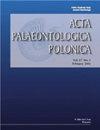Reexamination of the Mandibular and Dental Morphology of the Early Jurassic Mammaliaform Hadrocodium wui
IF 1.9
3区 地球科学
Q2 PALEONTOLOGY
引用次数: 3
Abstract
Reexamination of the mandibular and dental morphology of the Early Jurassic mammaliaform Hadrocodium wui. CT visualization of the mandible and dentition of Hadrocodium wui , a stem mammaliaform from the Lower Jurassic Lower Lufeng Formation of Yunnan, China has revealed new features not accessible by previous microscopic study of the fossil. Its mandible shows a postdentary trough with an overhanging medial ridge and a short Meckel’s sulcus. An incomplete part of the ectotympanic and possibly a remnant of Meckel’s element are preserved in the postdentary trough. Thus, Hadrocodium is similar to other mammaliaforms in retaining a mandibular middle ear, contrary to our earlier interpretation. The mandible exhibits a large postcanine diastema from shedding of anterior premolars without replacement, an age-dependent feature better developed in older adults. Another adult feature is the alignment of the ultimate molar to the coronoid process. This is consistent with age-dependent changes in other mammaliaforms where the last molars of the toothrow shift from medial of the coronoid process in the juvenile, to a position in front of the coronoid process in the adult. The mandible has a short mobile symphysis. The dentition consists of I5, C1 (two-rooted), P3 (including P1 position) and M2 (M2 with confluent roots), and i4, c1 (partially two-rooted), p3, and m2 (m2 with partially confluent roots). The two-rooted upper canines are more derived than other Early Jurassic mammaliaforms from the same fauna, although similar to docodontans. Hadrocodium is unique in that the lower m2 cusp a occludes in the embrasure between upper M1–M2, but the posterior part of m2 shows between-cusp occlusion with upper M2 main cusp A. M2 is half the size of the lower m2, and occludes only with the distal half of m2. The upper postcanines show a steep gradient of posteriorly decreasing tooth size, more so than other mammaliaforms. The CT examination corroborates that there are no unerupted teeth in the upper or lower jaws, and the holotype of H. wui is dentally and osteologically mature and capable of independent feeding.早侏罗世吴氏硬齿哺乳动物下颌和牙齿形态的再研究
早侏罗世吴氏硬齿哺乳动物下颌和牙齿形态的再研究。来自中国云南下侏罗统下陆峰组的一种干哺乳动物Hadrocodium wui的下颌骨和牙列的CT可视化显示了以前对化石进行显微镜研究无法获得的新特征。下颌骨有牙后沟,内凸脊和短梅克尔沟。外鼓室的不完整部分和可能残余的梅克尔元素保存在后牙槽中。因此,Hadrocodium与其他哺乳动物相似,保留了下颌中耳,这与我们之前的解释相反。下颌骨由于前前磨牙脱落而无替代物,表现出较大的犬后间隙,这是一种年龄依赖性特征,在老年人中发展得更好。另一个成人的特征是最终的磨牙对准冠突。这与其他哺乳动物的年龄依赖性变化是一致的,在这些哺乳动物中,牙齿的最后一颗臼齿从幼年动物的冠突内侧移动到成年动物的冠突前方。下颌骨有短的活动联合。牙列由I5、C1(两根)、P3(包括P1位置)和M2(根融合M2)组成,i4、C1(部分两根)、P3和M2(根部分融合M2)组成。双根上犬科动物与其他早侏罗世哺乳动物相比,更多地来自同一动物群,尽管与齿齿类相似。Hadrocodium的独特之处在于下m2尖a闭塞在上M1-M2之间的间隙,但m2的后部与上m2主尖a呈尖间闭塞。m2的大小为下m2的一半,仅与m2的远端一半闭塞。上颌后犬齿的牙齿大小呈陡峭的下降趋势,比其他哺乳动物更明显。CT检查证实上颌和下颚均无未出牙,吴氏人牙骨发育成熟,能独立进食。
本文章由计算机程序翻译,如有差异,请以英文原文为准。
求助全文
约1分钟内获得全文
求助全文
来源期刊

Acta Palaeontologica Polonica
地学-古生物学
CiteScore
2.80
自引率
5.60%
发文量
36
审稿时长
12.5 months
期刊介绍:
Acta Palaeontologica Polonica is an international quarterly journal publishing papers of general interest from all areas of paleontology. Since its founding by Roman Kozłowski in 1956, various currents of modern paleontology have been represented in the contents of the journal, especially those rooted in biologically oriented paleontology, an area he helped establish.
In-depth studies of all kinds of fossils, of the mode of life of ancient organisms and structure of their skeletons are welcome, as those offering stratigraphically ordered evidence of evolution. Work on vertebrates and applications of fossil evidence to developmental studies, both ontogeny and astogeny of clonal organisms, have a long tradition in our journal. Evolution of the biosphere and its ecosystems, as inferred from geochemical evidence, has also been the focus of studies published in the journal.
 求助内容:
求助内容: 应助结果提醒方式:
应助结果提醒方式:


